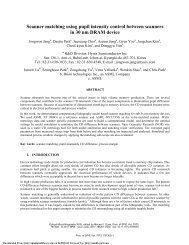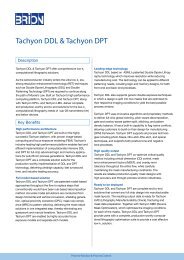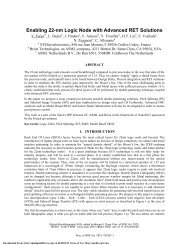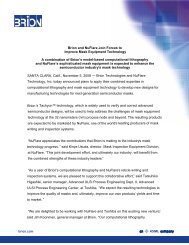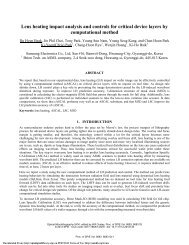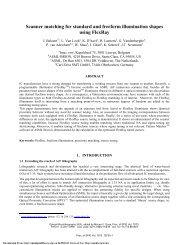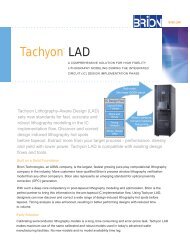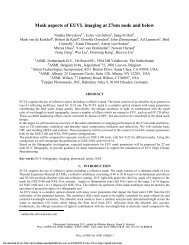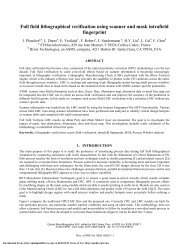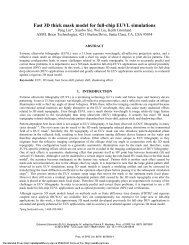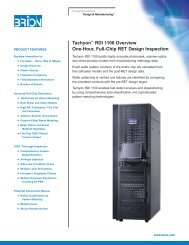Holistic lithography for EUV - Brion Technologies, Inc.
Holistic lithography for EUV - Brion Technologies, Inc.
Holistic lithography for EUV - Brion Technologies, Inc.
- No tags were found...
You also want an ePaper? Increase the reach of your titles
YUMPU automatically turns print PDFs into web optimized ePapers that Google loves.
Invited Paper<br />
<strong>Holistic</strong> <strong>lithography</strong> <strong>for</strong> <strong>EUV</strong>: NXE:3100 characterization of first<br />
printed wafers using an advanced scanner model and scatterometry<br />
Frank A. J. M. Driessen, N. Davydova, J. Jiang a , H. Kang b , V. Vaenkatesan, D. Oorschot, I.S. Kim c ,<br />
S.N. Kang c , Y. Lee c , J. Yeo c , K. Gronlund a , H.Y. Liu a , K. van Ingen-Schenau, R. Peeters,<br />
C. Wagner, J. Zimmermann d , O. Schumann d<br />
ASML Netherlands B.V., De Run 6501, 5504 DR Veldhoven, The Netherlands<br />
a ASML-<strong>Brion</strong> <strong>Technologies</strong> <strong>Inc</strong>orporated, 4211 Burton Drive, Santa Clara, CA 95054, USA<br />
b ASML Technology Development Center, 4211 Burton Drive, Santa Clara, CA 95054, USA<br />
c Samsung Electronics, Co.,Ltd., San #16 Banwol-Dong, Hwasung-City, Gyeonggi-Do, Korea<br />
d<br />
Carl Zeiss SMT GmbH, 73446 Oberkochen, Germany<br />
ABSTRACT<br />
In this paper we will present ASML’s holistic approach to <strong>lithography</strong> <strong>for</strong> <strong>EUV</strong>. This total approach combines the<br />
various components needed to achieve the correct on-product demands of our customers in terms of patterning fidelity<br />
across the entire image field and across the entire wafer.<br />
We will start giving a general update on ASML’s NXE scanner plat<strong>for</strong>m of which the 6 th NXE:3100 systems is now<br />
being shipped to a leading chipmaker. The emphasis will be on wafer imaging results <strong>for</strong> various applications such as<br />
flash memory and logic’s SRAM. Then we will describe the second holistic component, NXE-computational<br />
<strong>lithography</strong>, which was developed to speed-up early learning on <strong>EUV</strong> and to achieve high accuracy on the wafers.<br />
Thirdly, the YieldStar angular-resolved scatterometry tool that supports the scanner’s stability was used to characterize<br />
the system and calibrate the models.<br />
The wafer-results reveal in detail predicted imaging effects of NXE <strong>lithography</strong> and allow a calibration of system<br />
parameters and characterization of hardware components. We will demonstrate mask-induced imaging effects and<br />
propose an improvement of the current <strong>EUV</strong> blank or mask-making processes.<br />
Keywords: <strong>EUV</strong>, <strong>lithography</strong>, flare, NXE, scanner, reticle, photo-mask, CDU, imaging<br />
1. INTRODUCTION<br />
ASML’s holistic <strong>lithography</strong> was introduced in 2009 1 <strong>for</strong> ArF-immersion <strong>lithography</strong> around the start of the 32-nm<br />
node. By integrating computational <strong>lithography</strong>, wafer <strong>lithography</strong> and process control, the industry’s technology shrinks<br />
could be developed in a better way through co-optimization. For instance, with holistic <strong>lithography</strong>, manufacturing<br />
in<strong>for</strong>mation and detailed models of the optics in the scanner are made available to the chip-design phase (<strong>for</strong> instance <strong>for</strong><br />
source-mask optimization). Furthermore, <strong>lithography</strong> cluster and other process behavior can be stabilized in a better<br />
way.<br />
In this paper we introduce and apply the concept of holistic <strong>lithography</strong> to <strong>EUV</strong>. Computational models have been<br />
developed that contain details of the newly introduced NXE scanner plat<strong>for</strong>m and of generic <strong>EUV</strong> effects such as those<br />
of <strong>EUV</strong> masks and the impact that flare has on each different mask layout. With these computational capabilities -which<br />
are available be<strong>for</strong>e the scanners are actually introduced to the field- ASML’s customers will be capable of better<br />
understanding <strong>EUV</strong> <strong>lithography</strong> on their IC-devices and speed up their learning cycles in the semiconductor factories.<br />
The same holds <strong>for</strong> the mask-making industry: With the predictive computational tools the mask materials and process<br />
can be developed in a better way such as will be exemplified in this paper. The NXE scanners have a lot of metrology<br />
on board <strong>for</strong> system control and read out; however some of the metrology can be off-loaded to ASML’s metrology tool<br />
YieldStar, which can either be positioned as a module integrated in a track, or stand-alone in the clean-room to control<br />
Photomask Technology 2011, edited by Wilhelm Maurer, Frank E. Abboud,<br />
Proc. of SPIE Vol. 8166, 81660Z · © 2011 SPIE · CCC code: 0277-786X/11/$18 · doi: 10.1117/12.898955<br />
Proc. of SPIE Vol. 8166 81660Z-1<br />
Downloaded From: http://proceedings.spiedigitallibrary.org/ on 04/08/2013 Terms of Use: http://spiedl.org/terms
the full process in the <strong>for</strong>mer case, and multiple litho-clusters in the latter. This is of special importance during highvolume<br />
manufacturing (HVM). YieldStar is unique in that it is capable of measuring overlay, CD uni<strong>for</strong>mity, resist<br />
thickness as well as focus (focus being under development in <strong>EUV</strong>) and it can interface with scanners through a product<br />
called BaseLiner to further stabilize the scanners. A schematic overview of the holistic <strong>lithography</strong> concept is shown in<br />
Figure 1. In the near future we will see further enhanced automation and data transfer between the three major<br />
components that <strong>for</strong>m <strong>EUV</strong> holistic <strong>lithography</strong>.<br />
In this paper we will describe the components of this total <strong>lithography</strong> approach and we will give examples how it was<br />
used to verify wafer results and compare them with predictions.<br />
Figure 1: Schematic explaining holistic <strong>lithography</strong> <strong>for</strong> <strong>EUV</strong>: mutual interaction and integration of 1) NXE wafer exposure <strong>for</strong><br />
production, with 2) computational <strong>lithography</strong> <strong>for</strong> prediction and (mask) correction, and 3) dedicated metrology <strong>for</strong> verification and<br />
control during high-volume manufacturing (HVM).<br />
2. NXE SCANNER UPDATE<br />
2.1 Scanner update<br />
The NXE:3100 systems are ASML’s first generation <strong>EUV</strong> scanners <strong>for</strong> the semiconductor factories; they transfer the<br />
learning of the two alpha-demo tools at IMEC and Albany to the industry. The NXE:3100 has been manufactured in a<br />
limited edition. The year 2011 truly marks the introduction of <strong>EUV</strong> scanners to the industry: six NXE:3100’s have been<br />
transferred to customers. While writing this paper, three of them were exposing wafers, two of them were under<br />
installation and one was in final shipment phase.<br />
The default illumination mode of the NXE:3100 has a numerical aperture (NA) of 0.25 and conventional illumination at<br />
σ _outer = 0.8. A selection of popular off-axis illumination (OAI) modes is possible as well albeit at the cost of a reduction<br />
of precious <strong>EUV</strong> light intensity. The NXE:3100 is intended to enable the 27-nm half-pitch node. An early per<strong>for</strong>mance<br />
validation has been reported by C. Wagner et al. 2<br />
The NXE plat<strong>for</strong>m is designed to support multiple technology nodes. The second generation scanner from this plat<strong>for</strong>m,<br />
the NXE:3300, will have an NA=0.33, a maximum σ _outer = 0.9, a selected set of loss-less OAI modes, and it intends to<br />
serve the industry down to 16-nm resolution. The NXE:3300 will also have again further-reduced flare values, higher<br />
source power, as well as a significantly lower footprint, which are all important factors <strong>for</strong> volume manufacturing.<br />
Proc. of SPIE Vol. 8166 81660Z-2<br />
Downloaded From: http://proceedings.spiedigitallibrary.org/ on 04/08/2013 Terms of Use: http://spiedl.org/terms
2.2 Imaging results with the NXE:3100<br />
This section summarizes imaging results <strong>for</strong> various CMOS device applications as obtained on the NXE:3100 at ASML<br />
premises. The NXE:3100 is specified <strong>for</strong> 27-nm node imaging but a lot of emphasis is given to extending its resolution.<br />
Figure 2 shows SEM images <strong>for</strong> 22-nm node NAND flash wordline (WL) and contact-hole (CH) layers 3 . The process<br />
used was a 50-nm layer of SPURV002 photo-resist on 20nm under layer (UL). TBAH was used as developer and a DIwater<br />
rinse was used. Illumination used was dipole-X at 75-degree opening angle. Best doses used were 9.5 mJ/cm 2 <strong>for</strong><br />
the line-space (L/S) mask and 13.0 mJ/cm 2 <strong>for</strong> the CH mask. The half-pitch <strong>for</strong> the WL mask was 22 nm and that <strong>for</strong> the<br />
CH mask was 24-nm. The corresponding process window <strong>for</strong> 22-nm 1:1 dense L/S under these conditions was measured<br />
to have 12% exposure latitude (EL) at 200-nm depth-of-focus (DOF); the Bossung curves associated to this are shown at<br />
the right of Figure 2.<br />
22nm DoF ~ 200nm, EL ~ 12%<br />
17<br />
-0.2 -0.1 0.0 0.1 0.2<br />
Focus Offset (μm)<br />
Figure 2: 22nm node Flash memory wordline at pitch 44 nm (left) and contact holes (middle) at CH pitch of 48-nm. Patterns were<br />
resolved on NXE:3100 using dipole-X illumination at 75-degree opening angle. Under these conditions the process window <strong>for</strong> 22-nm<br />
1:1 dense L/S was 200-nm DOF at 12% exposure latitude as shown in the picture at the right <strong>for</strong> which an organic resist was used..<br />
CD (nm)<br />
27<br />
22<br />
13.00 mJ/cm 2<br />
13.75<br />
14.5<br />
15.25<br />
16.00<br />
A staggered contact layer of pitch 65nm could also be well resolved as shown in Figure 3. Such staggered contacts are<br />
possibly part of the flash cells of the 18-nm node as indicated graphically in Figure 3 as well. The resist and developer<br />
process used was the same as described above with the exception that the DIW rinse was replaced by a FIRM 4 Extreme<br />
rinse. In Figure 3 also SEM images of 19 and 18-nm 1:1 dense L/S are shown, exposed using a 60-degree dipole<br />
illumination shape. At this squeeze of the resolution of NXE:3100 not much process window can be expected but it<br />
shows the imaging potential when going to the NXE:3300.<br />
18nm HP<br />
19p38 18p36<br />
Figure 3: Left: The 18-nm node flash memory staggered contact layer is resolved. Bit-lines of 18-nm half-pitch have been projected<br />
on top of the SEM image <strong>for</strong> illustration purposes (Ref.[3]). Middle and right: 1:1 dense lines of 19 nm and 18 nm were printed,<br />
respectively using 60-degree dipole illumination in collaboration with IMEC using Inpria inorganic negative tone resist.<br />
Proc. of SPIE Vol. 8166 81660Z-3<br />
Downloaded From: http://proceedings.spiedigitallibrary.org/ on 04/08/2013 Terms of Use: http://spiedl.org/terms
For logic and CPU applications the patterning capability of the SRAM is always a gating factor. In Figure 4 two mask<br />
layers of the 14-nm SRAM have been exposed; this SRAM has a bit cell size of 0.038 μm2. The left hand picture 2 shows<br />
the CH layer with half-pitch 30-nm and the right hand picture shows the metal-1 layer with half-pitch of 32-nm. Both<br />
masks are resolved well and obviously do need further optical-proximity correction (OPC) <strong>for</strong> all the details to print to<br />
target. Again the resist-process mentioned above with FIRM Extreme rinse was used.<br />
Figure 4: 14-nm node SRAM contact hole (left) and metal-1 layer (right) are well resolved on NXE:3100. Their half-pitches are 30<br />
and 32 nm, respectively.<br />
CD uni<strong>for</strong>mity across the field is an important metric <strong>for</strong> manufacturing. Figure 5 shows CDU across the image field <strong>for</strong><br />
32-nm and 40-nm contact holes along with a CD-SEM image of the 32-nm dense holes. 3σ CD variation values of<br />
1.8nm (left) and 1.4 nm (right) were achieved, respectively. A reticle-error correction was applied to the data.<br />
Figure 5: SEM Image of 32-nm dense contact holes (left), CD uni<strong>for</strong>mity (representing 3sigma CD variation) across the image field<br />
was determined to be 1.8 nm <strong>for</strong> 32nm dense contact holes (middle) and of 1.4 nm <strong>for</strong> 40 nm dense contact holes (right); reticle error<br />
correction was applied.<br />
3. COMPUTATIONAL LITHOGRAPHY UPDATE<br />
The Tachyon NXE computational litho product was used during this work to compare the predicted imaging details of<br />
<strong>EUV</strong> <strong>lithography</strong> with measurements in order to calibrate parameters of the system. This <strong>Brion</strong> product supports the full<br />
NXE scanner characteristics along with generic <strong>EUV</strong> litho effects. In particular, flare effects induced by surface<br />
roughness of mirrors at the atomic level are obviously important in <strong>EUV</strong> 5,6 litho because of the short actinic wavelength<br />
of 13.5 nm. First, Tachyon NXE supports this generic flare with its long-range component described by the flare-pointspread<br />
function of the projection lens as measured after lens manufacturing. Furthermore, it also models the effects that<br />
certain scanner parts have on this flare be<strong>for</strong>e it reaches the wafer; all these effects then are included in the calculation of<br />
the mask-layout-specific flare-map used in OPC flows. Second, Tachyon takes the reflective mask properties and<br />
Proc. of SPIE Vol. 8166 81660Z-4<br />
Downloaded From: http://proceedings.spiedigitallibrary.org/ on 04/08/2013 Terms of Use: http://spiedl.org/terms
material stack heights into account leading to shadowing effects that are a function of feature orientation and position on<br />
the mask 7 . Third, <strong>for</strong> proximity-effect compensation also details of scanner optics are modeled through slit such as 1) the<br />
details of the pupil shapes that contain discrete light spots (in contrast to the spatially continuous top-hat illumination in<br />
DUV <strong>lithography</strong>), 2) the behavior of pupils through slit, 3) other details of the projection lens such as the wavefront<br />
described by Zernikes. Numerous internal simulation studies were conducted to investigate the effects of the various<br />
scanner model components on 1 and 2-dimensional layout features. This was done both <strong>for</strong> NXE:3100 as well as <strong>for</strong> the<br />
upcoming NXE:3300. For the sake of brevity we can not report detailed results here but the general trends are that the<br />
benefits of including scanner imaging details increases <strong>for</strong> decreasing feature sizes and that they are more prominent <strong>for</strong><br />
logic applications than <strong>for</strong> memory applications. Furthermore, including the effects of anisotropies in flare can improve<br />
the within-field CD control significantly up to 1nm. One final result we would like to show is the CD effect of the pupil<br />
details on printability of 2D layout pattern. This pupil consists of a collection of intensity spots, the intensity of which<br />
has small but predictable differences per spot that arise from the exact paths that the light travels inside the illuminator<br />
lens as well as from the details of the plasma. Because two types of sources of the plasma are available, LPP (laserproduced<br />
plasma) source and DPP (discharge produced plasma), minor effects on CD could be present. Figure 6 shows<br />
the CD difference that results when details of LPP and DPP are included in the pupil. The case used is the NXE:3300<br />
scanner assuming 4% flare and a 7-nm resist blur <strong>for</strong> 22-nm features of interest. The RMS CD differences between LPP<br />
and DPP pupils through slit were found to be below 0.14 nm. Despite the fact that these effects are very small it is better<br />
to include the source details in the model to reduce their systematic CD impact.<br />
CD Difference RMS (nm)<br />
0.14<br />
0.12<br />
0.1<br />
0.08<br />
0.06<br />
0.04<br />
0.02<br />
0<br />
LPP-DPP Conventional<br />
LPP-DPP Quasar<br />
L/S 2bar brokenH Hbar LELE IsoPad TLE Contact<br />
Figure 6: Differences in simulation results of CD's of various 2D pattern using either LPP or DPP as source pupils. This<br />
was done <strong>for</strong> two illumination modes, conventional and quasar <strong>for</strong> the case of the NXE:3300. Further explanation is<br />
given in the text.<br />
4. EXPERIMENTAL CONDITIONS<br />
4.1 Photomask<br />
A special mask was designed by ASML to characterize imaging properties of the NXE scanner with emphasis on flare;<br />
furthermore it contains calibration structures <strong>for</strong> OPC. The design contains 30-nm dense line-space features to study 1)<br />
the flare point-spread function, 2) the symmetry of flare, 3) border-reflection effects, and 4) possible DUV reflections<br />
from the REMA-blade (a small fraction of DUV light is present in the source spectrum; its possible reflections should be<br />
well understood and controlled). The mask was manufactured at the captive mask shop of Samsung and reticle CDuni<strong>for</strong>mity<br />
data on it will be reported in the next section. Furthermore, multilayer reflectivity of 65% and absorber<br />
reflectivity of ~1% were measured at <strong>EUV</strong> wavelength of 13.5 nm by the mask shop. Finally, multilayer and absorber<br />
reflectance curves were available throughout the DUV-to-visible spectral region to ensure a proper analysis of effects.<br />
4.2 Wafer exposures and metrology<br />
Wafers were coated with a 50-nm thick photo-resist layer of Shin Etsu SPURV002. Nominal dose and focus settings<br />
were determined first from a FEM pathfinder wafer. The CD analysis of this wafer was done both by conventional<br />
Hitachi CD-SEM as well as by YieldStar 8 . Because of its excellent measurement accuracy (0.1nm details were resolved)<br />
and high speed (0.7 sec/measurement) YieldStar provided best value. We also used the YieldStar S100 to determine the<br />
Proc. of SPIE Vol. 8166 81660Z-5<br />
Downloaded From: http://proceedings.spiedigitallibrary.org/ on 04/08/2013 Terms of Use: http://spiedl.org/terms
esidual resist thickness after develop throughout the process window. YieldStar is furthermore capable of accurately<br />
measuring overlay effects but that was not part of this study. Wafer exposures were per<strong>for</strong>med on two NXE:3100<br />
scanners which both had laser-produced plasma (LPP) <strong>EUV</strong> sources. Conventional illumination was used with partial<br />
coherence of 0.8 at an NA of 0.25.<br />
5. RESULTS AND DISCUSSION<br />
5.1 Results on mask<br />
The layout of the mask used to investigate the NXE is shown at the left of Figure 7. It contains dense metrology arrays<br />
such as A and B intended to characterize through-slit fingerprints and corner effects. The mask-CDU of the full array<br />
through slit measured by YieldStar is shown at the right of Figure 7. Very good CDU uni<strong>for</strong>mity is observed of 0.8 nm<br />
(1σ). The two top corner arrays B even have a CDU of 0.5 and 0.6 nm. Pattern sequence C contains layout to measure<br />
the flare-PSF; the small pattern of dense lines in the center of them is embedded in large open areas of different shapes, a<br />
known tougher task to control <strong>for</strong> the etch step of the mask process. Nevertheless, the CDU of array C was still very<br />
good: 1.2 nm.<br />
Figure 7: Layout of an ASML reticle <strong>for</strong> characterization of NXE scanner effects and mask CD measurements on 30-nm 1:1 dense<br />
line-spaces from the bottom array A-{1-84}. Further CDU results are given in the text.<br />
5.2 Results on wafer<br />
A pathfinder FEM wafer was used to determine best dose and focus conditions. Figure 8 shows the Bossung curves<br />
derived from the mean-CD-FEM readouts by YieldStar (left). At a dose of 14mJ/cm 2 an almost iso-focal behavior is<br />
observed. The YieldStar S-100 data also allowed us to extract the post-develop resist thickness values throughout the<br />
process window. Throughout the process window this thickness was fairly stable at ~40nm. This corresponds to a<br />
thickness-reduction of ~20% cf. the applied thickness of 50 nm.<br />
Proc. of SPIE Vol. 8166 81660Z-6<br />
Downloaded From: http://proceedings.spiedigitallibrary.org/ on 04/08/2013 Terms of Use: http://spiedl.org/terms
50<br />
CD(nm)<br />
40<br />
30<br />
20<br />
10<br />
8<br />
8.75<br />
9.5<br />
10.25<br />
11<br />
11.75<br />
12.5<br />
13.25<br />
14<br />
0<br />
-200 -150 -100 -50 0 50 100 150 200<br />
Focus(nm)<br />
Figure 8: Bossung curves <strong>for</strong> best-focus, best-dose determination from YieldStar CD measurements with iso-focal plane achieved at<br />
~14mJ/cm2 (left); resist-height throughout the process window was ~40nm.<br />
Best dose and focus settings were then chosen to expose the wafers <strong>for</strong> the scanner imaging characterization. The wafer<br />
map used is shown in the in-set of Figure 9: both isolated fields (brown column in the center) as well as fields that have<br />
direct-neighbor fields exposed with zero-distance between the fields (field and image sizes of 26x32mm) are present on<br />
the wafer. The fields with neighbors can be separated in three different versions: fields with one, two and three neighbor<br />
exposures in the field corners, respectively.<br />
Figure 9 shows across-wafer CD measurements of horizontal lines with flare light either coming from vertically (V)<br />
oriented butterfly structures or from horizontally (H) oriented ones. Note that because the measurement features are the<br />
same, there is no difference in shadowing effect that will influence the results. The horizontal axis corresponds to the<br />
field positions on the wafer. These measurements were taken by CD-SEM. The average CD in cases of H-flare is 33.7<br />
±0.7nm and that in case of V-flare is 33.6 ±0.6nm. There<strong>for</strong>e, it can be concluded that <strong>for</strong> the NXE:3100 there is no flare<br />
difference caused by the orientation of the flare-generating open areas, which is indicative of the high isotropic quality of<br />
the mirror optics in the projection lens. As a matter of fact, if the 0.1nm difference would appear to be statistically<br />
significant, it could even be explained by the fact that the long-range flare at pattern V on the mask is slightly larger than<br />
that of pattern H on the mask. Flare map calculations by <strong>Brion</strong> indeed confirm this and predict a 0.1nm CD difference<br />
<strong>for</strong> the typical flare sensitivity of the resist used here.<br />
`<br />
CD [nm]<br />
35<br />
34<br />
33<br />
Across wafer: CD H-flare =CD V-flare<br />
32<br />
0 5 10 15 20 25 30 35 40 45 50<br />
Meas nr. (field)<br />
Figure 9: CD (nm) of horizontal lines measured across the wafer <strong>for</strong> flare originating from both vertical (V) butterfly structures and<br />
from horizontal (H) butterfly structures. The points on the horizontal axis correspond to the colored fields of the wafer map at the<br />
inset. No statistically significant CD difference is observed as a function of the different orientation of the flare-generating open areas.<br />
V<br />
H<br />
Proc. of SPIE Vol. 8166 81660Z-7<br />
Downloaded From: http://proceedings.spiedigitallibrary.org/ on 04/08/2013 Terms of Use: http://spiedl.org/terms
Spectral control of the light is important in <strong>EUV</strong> <strong>lithography</strong> because the created <strong>EUV</strong> plasma generates also a small<br />
light intensity in the DUV part of the optical spectrum. For both the ADT as well as <strong>for</strong> the NXE:3100, the IMEC team<br />
showed that the DUV content in the light that reaches the wafer was already shown to be less than 1% 9 . That was<br />
concluded by investigating the direct reflections from the field with a special mask with Aluminum parts. Here, we will<br />
investigate possible reflection effects of DUV light. The only candidates in the scanner to exhibit DUV reflections are<br />
the REMA-blades. We investigated a scanner with old prototype REMA blades as well as a scanner with the real<br />
NXE:3100 REMA blades. The <strong>for</strong>mer proto blades were known to have high reflectivity in the DUV, whereas the latter<br />
production ones have low DUV reflectivity. The data in Figure 10 were achieved by subtracting the average CD field<br />
distribution of isolated fields from that of fields with neighbors. Furthermore, black-border reflection effects at the very<br />
edges of the fields were removed. The proto REMA blade case shows a residual CD fingerprint of maximum 0.8nm<br />
which is induced by a DUV reflection into the neighbor-field by the bottom REMA blade. The real NXE:3100 REMA<br />
does NOT show such characteristic fingerprint at all. This proves that DUV reflections are having no impact on<br />
production wafers with the NXE and that the REMA blades were well designed. Note that the CD color scale is the<br />
same <strong>for</strong> both plots. It may further be remarked that the metrology accuracy of these data achieved by YieldStar is<br />
extremely good: 0.1 nm CD differences are well resolved from it.<br />
15<br />
Proto REMA:<br />
0.3<br />
15<br />
NXE:3100 REMA:<br />
0.3<br />
10<br />
5<br />
•0.8 nm CD range<br />
at wafer<br />
0.2<br />
0.1<br />
0.0<br />
10<br />
5<br />
•No REMA DUV-R<br />
signature<br />
0.2<br />
0.1<br />
0<br />
0<br />
-5<br />
(high DUV-Reflectivity)<br />
-0.1<br />
-0.2<br />
0<br />
-5<br />
(low DUV-Reflectivity)<br />
-0.1<br />
-0.2<br />
-10<br />
-0.3<br />
-10<br />
-0.4<br />
-0.3<br />
-0.4<br />
-15<br />
-10 -5 0 5 10<br />
-0.5<br />
-15<br />
-10 -5 0 5 10<br />
-0.5<br />
Figure 10: A prototype REMA shows a residual CD fingerprint arising from high reflectivity of residual DUV light in the lightsource<br />
(left); the production NXE:3100 REMA (with low DUV-R) shows absence of such fingerprint (right); CD color scales are identical<br />
<strong>for</strong> both plots.<br />
Another important topic of interest in imaging with <strong>EUV</strong> photo masks stems from the fact that the mask-absorber stack<br />
does not (yet) have zero reflectance. This is not so much an issue <strong>for</strong> the dark features inside the field but it is of concern<br />
<strong>for</strong> the so-called black-border region (usually a ring-shaped border which optically isolates separate image-fields on a<br />
mask, and which also will capture the half-shadow (penumbra) in reflective <strong>lithography</strong>). Currently mask-black-border<br />
reflectivity values reported range from 0.5 to 2%: the thinner the absorber stack, the higher the reflectivity. Because of<br />
non-zero reflectivity of the black border (BB), <strong>EUV</strong> light can be reflected to the edges of the neighbor field. In field<br />
corners this can happen 2 or 3 times, depending on the number of neighbor fields.<br />
In Figure 11 we show wafer YieldStar measurement again obtained by subtracting average CD values in isolated fields<br />
from those of densely packed fields. From left to right, one, two and three neighboring field exposures were present.<br />
The range of influence of this effect is typically a few 100 microns from the edge. In the presence of one neighbor field<br />
we observed a CD decrease of ~2.8nm at the field edges. In the field corners <strong>for</strong> the case of two and three neighbors, the<br />
CD decrease <strong>for</strong> L/S was ~5.2 and ~7.5nm, respectively. Especially in the corners this impact is large and we there<strong>for</strong>e<br />
urge mask makers to focus on mask process developments that further reduce the black-border reflectivity.<br />
Proc. of SPIE Vol. 8166 81660Z-8<br />
Downloaded From: http://proceedings.spiedigitallibrary.org/ on 04/08/2013 Terms of Use: http://spiedl.org/terms
Figure 11: Effects on CD caused by mask-black-border reflections at the edges and corners of a field. Schematic at the left illustrating<br />
light reflection at the BB. The three colored pictures represent –from left to right- the measured CD’s of 30-nm dense L/S in the topleft<br />
corner of the field in the presence of 1, 2 and 3 neighboring fields. At the edges of the field the CD decreases as a result of mask-<br />
BB reflection. Values are given in the text.<br />
Tachyon NXE computational <strong>lithography</strong> can model the effects observed. In Figure 12 simulations and experimental<br />
results are compared head-to-head in a corner of the image field. For more detail on these simulations we refer to the<br />
work of N. Davydova et al. 10 at this conference. In Figure 15 of that paper, which at liberty is repeated here as the right<br />
graph of Figure 12, experimental and simulation data are shown along a cut-line <strong>for</strong> both horizontally and vertically<br />
oriented features. OPC will have a potential to correct <strong>for</strong> this effect but it will be preferential if the size of the BB effect<br />
is reduced by reducing the BB reflectivity.<br />
28<br />
Tachyon simulation of image border reflection<br />
effect of NXE:3100 data<br />
CD, nm<br />
27<br />
26<br />
25<br />
24<br />
24H54 meas<br />
23<br />
24H54 sim<br />
26V54 meas<br />
22<br />
26V54 sim<br />
21<br />
0 0.2 0.4 0.6 0.8 1<br />
distance to neighboring field, mm<br />
Figure 12: Simulation vs. wafer measurement match excellently: (left) Tachyon NXE simulation of mask-black-border<br />
effect <strong>for</strong> the CD features and the mask used in this experiment in the corner of the image field; (middle) YieldStar CD<br />
measurement of mask black-border effect. The right graph is from N. Davydova et al.[Ref.10] showing matching<br />
between simulation and her wafer-experiment <strong>for</strong> both horizontal and vertical features.<br />
We would like to conclude this chapter by presenting good, independent model validation results on wafer flare as<br />
measured by IMEC and compare them with simulated flare maps by <strong>Brion</strong>’s Tachyon NXE. For both the early ADT<br />
tool and the NXE:3100 detailed flare measurements were taken with a differently designed mask; this was done in the<br />
scan direction. Figure 13 shows these results <strong>for</strong> both the ADT with its high flare as well as <strong>for</strong> the NXE:3100 with low<br />
flare. The method uses open-frame measurements (so a real production mask will show much lower flare numbers) and<br />
has measurement features located at the edge of the field where the flare variations are known to be largest. An excellent<br />
match was obtained between wafer measurements and the simulated values. Similarly good results were obtained in the<br />
slit direction.<br />
Proc. of SPIE Vol. 8166 81660Z-9<br />
Downloaded From: http://proceedings.spiedigitallibrary.org/ on 04/08/2013 Terms of Use: http://spiedl.org/terms
14.5<br />
ADT flare vs. position<br />
5<br />
4.5<br />
p<br />
NXE:3100 flare vs. position<br />
Flare (%)<br />
12.5<br />
Flare (%)<br />
10.5<br />
3.5<br />
Measured<br />
8.5<br />
3<br />
Simulated<br />
6.5<br />
2.5<br />
0 2 4 6 8<br />
Position (a.u.)<br />
4<br />
Measured<br />
Simulated<br />
0 2 4 6 8<br />
Position (a.u.)<br />
Figure 13: Measured flare data on wafer positions in the scan directions by IMEC (solid circles) vs. predicted flare values (simulated<br />
curves) at different positions on the mask. Validation was done <strong>for</strong> both the ADT as well as <strong>for</strong> the NXE:3100.<br />
6. SUMMARY<br />
We have introduced holistic <strong>lithography</strong> in <strong>EUV</strong> <strong>for</strong> the plat<strong>for</strong>m of NXE scanners: An integral approach that combines<br />
the capabilities of the NXE exposure tools with accurate predictive modeling and tailored metrology. We applied this<br />
concept to the first wafers exposed with the NXE:3100 scanners.<br />
We gave a review of the status of the NXE scanner plat<strong>for</strong>m. With now six NXE:3100 scanner shipments to the field, the<br />
year 2011 can be marked as the year that <strong>EUV</strong> made its start to integration in the FABs. Extended imaging capabilities<br />
beyond the 27-nm targets were demonstrated <strong>for</strong> flash memory, logic-SRAM and dense contact hole applications with<br />
decent process windows <strong>for</strong> 22-nm and with imaging resolution down to 18-nm.<br />
The imaging behavior of ASML’s first prototype manufacturing plat<strong>for</strong>m NXE:3100 has been modeled in detail <strong>for</strong><br />
computational <strong>lithography</strong> purposes. The model includes the optical system (pupil, slit, reflective projection lens), <strong>EUV</strong>specific<br />
flare effects (extending from short to very long-range), the <strong>EUV</strong> mask properties, and other NXE:3100 hardware<br />
components. The accuracy of the model through the image-field was demonstrated by comparing it to wafer<br />
measurements. Accurate predictive modeling of the entire image-field is of high importance <strong>for</strong> ASML’s customers to<br />
generate reliably (OPC) corrected and full-chip litho verified masks <strong>for</strong> a successful introduction of <strong>EUV</strong> to their FABs,<br />
thereby reducing learning cycles.<br />
We presented printed wafer results using a special mask that was designed by ASML and manufactured by Samsung’s<br />
captive mask shop. The mask measurements showed excellent uni<strong>for</strong>mity and quality. The mask was designed to be able<br />
to characterize the specific flare details of <strong>EUV</strong> <strong>lithography</strong> such that parameters in the model could be extracted.<br />
Furthermore, the measurements yielded in<strong>for</strong>mation on the quality of the projection optics in the NXE:3100.<br />
The wafers were measured <strong>for</strong> CD uni<strong>for</strong>mity by an ASML YieldStar S-100 scatterometry tool. After careful analysis of<br />
the large set of data, the results revealed predicted imaging effects of <strong>lithography</strong> such as flare details and residual blackborder<br />
reflections from the mask absorber stack. Furthermore, it was shown that there was no wafer CD impact caused<br />
by out-of-band DUV reflections in the NXE:3100 scanners.<br />
ACKNOWLEDGMENTS<br />
The teams of Samsung Memory and Samsung Maskshop are greatly acknowledged <strong>for</strong> their support. Gian Lorusso of<br />
IMEC is acknowledged <strong>for</strong> his cooperation on flare and permission to show the measurement data in figure 13. Fruitful<br />
interaction with ASML’s Eelco van Setten, Stuart Young, Hans Meiling, Noreen Harned and Jos Maas is greatly<br />
acknowledged. Finally, we want to thank Martin Lowisch, Martin Endres and Michael Patra of Carl Zeiss <strong>for</strong> their<br />
important contributions to modeling.<br />
Proc. of SPIE Vol. 8166 81660Z-10<br />
Downloaded From: http://proceedings.spiedigitallibrary.org/ on 04/08/2013 Terms of Use: http://spiedl.org/terms
REFERENCES<br />
[1] B. Koek, J. Koonmen, "ASML Introduces <strong>Holistic</strong> Lithography solutions to Continue Moore's Law", at SEMICON<br />
West, Press Release, see www.asml.com (2009).<br />
[2] C. Wagner, J. Bacelar, N. Harned, E. Loopstra, S. Hendriks, I. De Jong, P Kuerz, L. Levasier, M van de Kerkhof,<br />
M. Lowisch, H. Meiling, D. Ockwell, R. Peeters, E. Van Setten, J. Stoeldraijer, S. Young, J. Zimmerman, Ron Kool,<br />
"<strong>EUV</strong> Lithography at Chipmakers has started: Per<strong>for</strong>mance Validation of ASML's NXE:3100", Proc. SPIE 7969,<br />
79691F-1 (2011).<br />
[3] J. Miyazaki, "<strong>EUV</strong> <strong>lithography</strong> into production at chipmakers: update on ASML's NXE plat<strong>for</strong>m", 7th Annual<br />
SEMATECH Symposium Japan, (2011).<br />
[4] K. Petrillo, G. Huang, D. Ashworth, J. Georger, L. Ren, K. Y. Cho, W. Montgomery, S. Wurm, S. Kawakami, S.<br />
Dunn, and A. Ko, "Line width roughness control and pattern collapse solutions <strong>for</strong> <strong>EUV</strong> patterning", Proc. SPIE 7969,<br />
796913 (2011).<br />
[5] G.F. Lorusso, A.M. Goethals, R. Jonckheere, J. Hermans, K. Ronse, A.M. Meyers, I. Kim, A. Niroomand, F.<br />
Iwamoto, and D. Ritter, "Extreme ultraviolet <strong>lithography</strong> at IMEC: Shadowing compensation and flare mitigation<br />
strategy", Proc. SPIE 7969, 79692O-1 (2011).<br />
[6] H. Aoyama, Y. Tanaka, T. Kamo, N. Iriki, Y. Arisawa, and T. Tanaka, "Flare evaluation <strong>for</strong> 32-nm half pitch using<br />
SFET", Proc. SPIE 6921, 69213H (2009).<br />
[7] C. W. Ng, Kuen-Yu Tsai, Yen-Min Lee, Fu-Min Wang, Jia-Han Li, and Alek C. Chen, "Fully model-based<br />
methodology <strong>for</strong> simultaneous correction of extreme ultraviolet mask shadowing and proximity effects", J.<br />
Micro/Nanolith. MEMS MOEMS 10, 013004 (2011).<br />
[8] J. Maas, M. Ebert, K. Bhattacharyya, H. Cramer, A. Becht, S. Keij, R. Plug, A. Fuchs, M. Kubis, T. Hoogenboom,<br />
and V. Vaenkatesan, "YieldStar: a new metrology plat<strong>for</strong>m <strong>for</strong> advanced <strong>lithography</strong> control", Proc. SPIE 7985,<br />
79850H (2011).<br />
[9] G. F. Lorusso, N. Davydova, M. Eurlings, C. Kaya, Y. Peng, K. Feenstra, T. H. Fedynyshyn, O. Natt, P. Huber, C.<br />
Zaczek, S. Young, P. Graeupner, and E. Hendrickx, “Deep ultraviolet out-of-band contribution in extreme ultraviolet<br />
<strong>lithography</strong>: predictions and experiments”, Proc. SPIE 7969, 79692O (2011).<br />
[10] N. Davydova, E. van Setten, S-I Han, M. van de Kerkhof, R. de Kruif, D. Oorschot, J. Zimmerman, A. Lammers,<br />
B. Connolly, F. Driessen, A. van Oosten, M. Dusa, Y. van Dommelen, N. Harned, J. Jiang, W. Liu, H. Kang, H. Liu,<br />
“Mask aspects of <strong>EUV</strong>L imaging at 27nm node and below”, Proc. SPIE 8166-67 (2011).<br />
Proc. of SPIE Vol. 8166 81660Z-11<br />
Downloaded From: http://proceedings.spiedigitallibrary.org/ on 04/08/2013 Terms of Use: http://spiedl.org/terms



